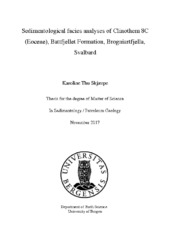| dc.description.abstract | The Eocene Battfjellet Formation in Van Keulenfjorden, Spitsbergen, Svalbard, has been investigated on the basis of a logged section at eastern Brogniartfjella. A comprehensive study of clinothem 8C, with focus on facies distribution, sandbody geometry and masterbedding architecture has been fulfilled. The sedimentary structures revealed influence from unidirectional and bidirectional currents. The studied clinothem 8C demonstrate a clear dichotomy both in internal structures and the external architecture. The proximal part of the unit presents progradational delta front lobe deposits deposited at the shelf, which display a high degree of wave reworking, characterised by an external tabular architecture. The succession can be laterally traced into the downslope subaqueous channel infill deposits, dominating the shelf-edge- to upper slope segment of the studied succession. The abundance of multiple local erosional surfaces, the dominance of current generated structures as well as the widespread distribution of soft-sediment deformed units imply deposition in a dynamic environment, supplied with sediments from the rising hinterland. Rip-up mud conglomerates, coal fragments, coal conglomerates (coffee ground) and the low degree of bioturbation substantiates this notion. The clinoforms at the Brogniartfjella corresponds to an overall falling shelf-edge trajectory. The evolution of clinothem 8C can be explained by deposition of a prograding wave dominated delta front during high relative sea-level, followed by relative sea level fall succeeded by multiple erosional subaqueous channelized units, presenting turbiditic and hyperpycnal erosion and deposition. The clinothem is bounded by marine deposits of the transgressive system tract. The combination of highstand, forced regression, lowstand wedge and transgressive system tracts summarize the studied clinothem. The study confirms the general notion of a foreland basin dominated by high supply of sediments. The tectonically active hinterland provided high sedimentation rates, whereas the narrow shelf in concert with a warm climate represent ideal conditions for establishment of shelf-edge deltas, slope wedges and associated deep water deposition. The succession represents deposition during an overall regression, which resulted in the final infill of the Central Basin. The study has improved the general understanding of the origin and development of shelfedge clinoforms, and bears important information about the shelf-edge to- slope system which represents a key element in the understanding shallow to deep marine reservoirs. | en_US |
